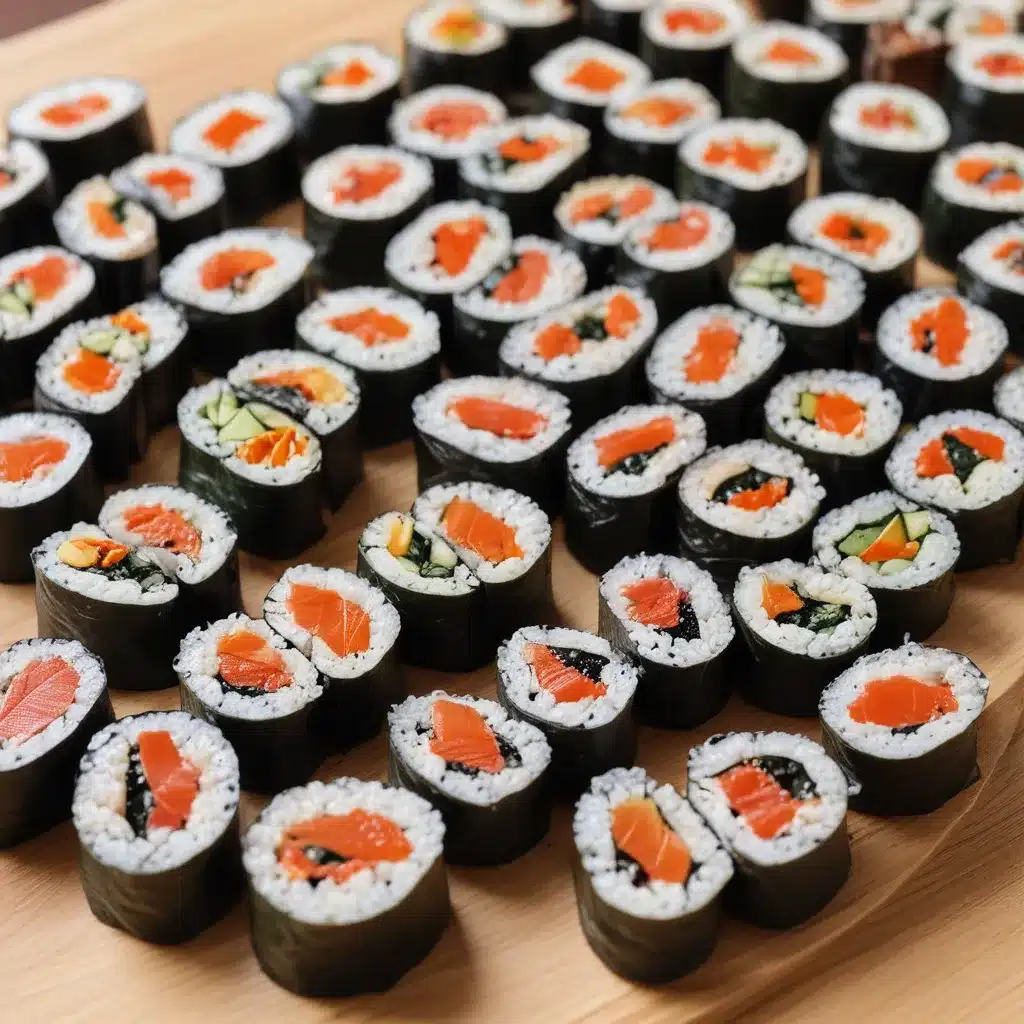
Kimbap: Korea’s Favorite Snack on the Go
If you ask any Korean, they’ll tell you that kimbap is one of the most popular snacks in the country. These seaweed-wrapped rolls are a staple at bus stations, school picnics, and pretty much any gathering where snacks are a must. But as a newcomer to the world of Korean cuisine, you might be wondering, “What exactly is kimbap, and how do I make it?” [1]
Well, let me tell you, kimbap is the ultimate versatile snack. The only limit to the fillings is your imagination – you can find everything from tuna to avocado to bulgogi (marinated beef) stuffed inside these portable rolls. But the classic version, with ingredients like imitation crab, pickled radish, and braised burdock root, is a great place to start. [1]
Gathering the Ingredients
One of the biggest challenges for first-time kimbap makers is tracking down all the necessary ingredients. Sure, you can find the basic stuff like seaweed sheets and rice at any Asian grocery store, but some of the more authentic fillings might require a trip to a specialty Korean market. [1]
For example, the pickled radish (known as danmuji in Korean) can come as whole pickled radishes that you have to cut into strips, or as pre-cut sticks ready to go into your kimbap. Either one works, but if you’re cutting your own, you’ll want to slice the radish about 1/4 inch thick and as long as the seaweed sheets. [1]
Another key component is the braised burdock root. This earthy, slightly sweet vegetable is often sold in packages by itself, but you might be able to find combo packs with the pickled radish, which is super convenient. [1]
And then there’s the fishcake, often called odeng or eomuk. This can be a bit tricky to track down, but just look for the rectangular, lightly colored cakes in the refrigerated section of your Korean market. [1]
The Art of Assembly
Now that you’ve got all your ingredients lined up, it’s time to put those kimbap together. The key is to prepare everything so that it’ll work seamlessly in the roll – that means cutting everything into thin, long strips that can span the entire length of the seaweed sheet. [1]
Start by seasoning your hot, freshly cooked rice with some sesame oil and crushed sesame seeds. Then, lay out a sheet of seaweed and spread the rice evenly across it, leaving a little bit of the seaweed exposed at the top. [1]
Next, it’s time to add the fillings. Arrange your carefully prepped ingredients – cucumber, egg, ham, carrot, fishcake, pickled radish, burdock root, and crab stick – in a neat line down the center of the rice. [1]
Now comes the fun part: roll it up! Using the bamboo mat, gently roll the seaweed and rice around the fillings, using your fingers to keep everything in place as you go. Seal the roll by wetting the exposed edge of the seaweed. [1]
Perfecting the Cut
Once your kimbap roll is all nice and tight, it’s time to slice it up. This is where a sharp knife and a little bit of patience come in handy. Lightly brush the rolls with some sesame oil, and then use a knife that’s also been lightly oiled to slice them into 1/2-inch thick pieces. [1]
The key is to cut through two rolls at once – it’s easier than doing one at a time. And don’t be afraid to apply a gentle squeeze to the rolls before slicing to help them hold their shape. [1]
And there you have it, your very own homemade kimbap! Serve these portable, flavorful rolls as a snack, a side dish, or even a light meal. Just be warned: once you start, it’s hard to stop at just one. [1]
Beyond the Classic Kimbap
Of course, the classic version of kimbap is just the beginning. Once you’ve mastered the basics, you can start getting creative with all sorts of fillings. [2,3,4,5,6,7,8]
How about tuna kimbap, with flaky chunks of fish and a drizzle of spicy mayo? Or avocado kimbap, for a creamy, veggie-packed twist? And let’s not forget the ever-popular bulgogi kimbap, featuring tender, marinated beef.
The possibilities are truly endless when it comes to kimbap. So get out there, experiment with different ingredients, and let your culinary creativity shine. Who knows, you might just become the kimbap master of your friend group!
Conclusion
Kimbap may seem like a simple snack, but there’s so much depth and tradition behind these humble seaweed rolls. From the carefully curated fillings to the art of assembly and slicing, every aspect of kimbap-making is a labor of love.
Whether you’re enjoying a classic kimbap or venturing out into more creative territory, one thing is certain: these portable, flavorful rolls are the perfect way to satisfy your Korean food cravings, no matter where you are. So what are you waiting for? Grab your seaweed sheets and get rolling!
References
[1] Knowledge from https://www.seriouseats.com/gimbap-korean-seaweed-rice-rolls
[2] Knowledge from http://www.koreanclass101.com/forum/viewtopic.php?t=806
[3] Knowledge from https://www.epicreads.com/blog/korean-food-101-by-ellen-oh/
[4] Knowledge from https://www.reddit.com/r/traderjoes/comments/15sefxz/guys_please_stop_buying_the_frozen_kimbap/
[5] Knowledge from https://spontaneoustomato.com/2013/02/21/kimchi-kimbap-and-easy-pickled-cucumber-banchan/
[6] Knowledge from http://cultivatorkitchen.com/vegan-kimbap/
[7] Knowledge from https://www.bokksumarket.com/blogs/magazine/kimbap-recipe
[8] Knowledge from https://www.tiktok.com/@ahnestkitchen/video/7267685798026153258?lang=en
